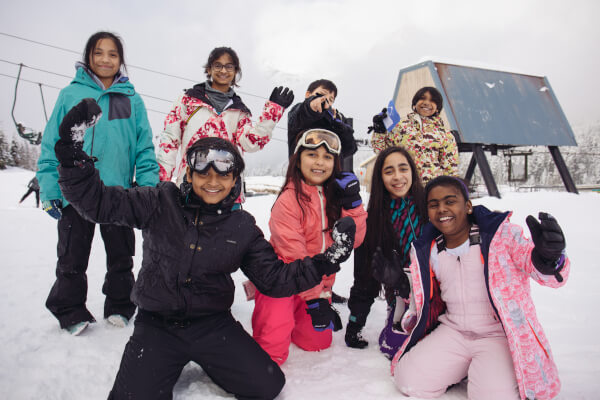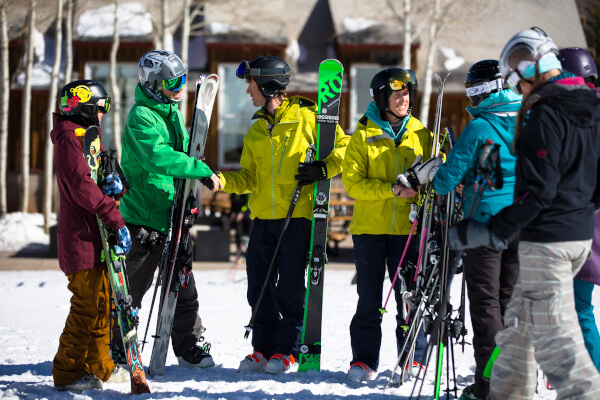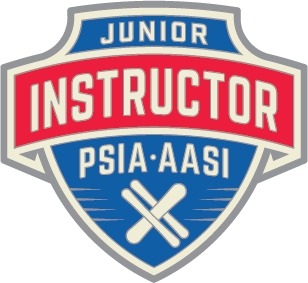This program introduces young adults to job opportunities in the snowsports industry. As a PSIA-AASI Member School, you can use this program to help your school to develop, train and grow your future instructor workforce. A better trained workforce helps benefit the entire snowsports industry.
PSIA-AASI hosts this entire program through an e-learning course on PSIA-AASI’s e-learning platform. Participating in this nationally recognized program is available to all PSIA-AASI Member Schools.
Watch This Video on How to Implement This Program at Your School
Watch this video, review this toolkit and the below content to learn how to set up this program for your school.

Photo Credit: SOS Outreach
Participant Requirements:
Participants must work with their local snowsports school to learn more about specific requirements, since every school may have a slightly different program. However, regardless of what school the participant chooses to work with, every candidate needs to complete the below minimum program requirements to complete this nationally recognized program and receive their official certificate of completion.
- Complete the entire Junior Instructor Certificate E-Learning Course on PSIA-AASI’s e-learning platform at lms.thesnowpros.org. A participant will need to take and pass three online modules:
- Course for New Instructors (1 hour)
- Delivering the Beginner Experience (alpine, snowboard, or cross country) (1 hour)
- Introduction to Working with Children (1 hour)
- Complete a 12-hour training course at a local resort. (12 hours)
- Shadow 6 hours of lessons at the resort’s ski and ride school. (6 hours)
- Demonstrate a minimum sliding ability in 2 areas:
- Must have the ability to maneuver safely in a learning area and around all surface lifts or up/down hills and trails.
- Must show the ability to safely ski or ride in a group on green terrain (beginner/novice zone).
- Complete the course portfolio and have it signed by a snowsports supervisor.
- Write and submit a letter of intent that describes why they want to become a snowsports instructor.
School Requirements:
Below are the minimum requirements for this program. The training must be delivered by a PSIA-AASI certified Level II non-discipline specific instructor. As long as these below minimum requirements are met, your school is welcome to build this program around your resort’s specific workforce and training needs.
- Be, or become, a PSIA-AASI Member School
- Develop a 12-hour training course at your resort. (If your school doesn’t have a Level II trainer, connect with your PSIA-AASI division office.)
- The course must be delivered by a Level II (any discipline).
- The course must:
- Focus the majority of training on snow (recommended by PSIA-AASI) and focus on movement based activities.
- Model an experiential approach to learning
- Provide an overview of snowsports school operational procedures.
- Develop a 6-hour shadowing program.
- To pass, participants must meet the below minimum sliding ability (any discipline):
- Have the ability to maneuver safely in a learning area and around all surface lifts or up/down hills and trails.
- Show the ability to safely ski or ride in a group on green terrain (beginner/novice zone) or up/down hills and trails.
On Snow Trainer Guidelines
You, or your trainer, can use the free PSIA-AASI’s Guide for New Instructors as a tool to create your in-house training program. Note there are nine learning outcomes we encourage your program include. Certificate candidates must be able to demonstrate they have learned and applied these tools to their own skills and training:
- PSIA-AASI Instructor Motto – Safety, Fun, Learning
- The Learning Partnership – Introduction to the PSIA-AASI Learning Connection model
- Responsibility Code and Park Smart
- Ski and Ride School Lesson Injury Procedures (e.g. what do you do if someone gets hurt?)
- Ski and Ride School Bathroom, Lunch and Lost Child Procedures
- Guest Service Skills – Introduce the Resort Guest Service Model
- Additional Training: How to interact with students’ parents, communication skills (e.g. eye contact, handshakes, etc.), and professionalism.
- Introduction to the CAP Model, VAK (Visual, Auditory, Kinesthetic), How People Learn: Watcher, Feeler, Doer, Thinker.
- Introduction to the Teaching/Learning Cycle and the Beginner Novice Zone – Discussion and review of e-learning courses.
Frequently Asked Questions (FAQs)
Q: Does my school need to be a PSIA-AASI Member School to deliver this certificate program?
A: Yes. Learn more about becoming a PSIA-AASI Member School and then email or call 303.987.9390 to sign up.
Q: What about non-member schools and community groups?
A: Non-PSIA-AASI member-schools and other groups not affiliated with PSIA-AASI, such as SOS Outreach, Boy Scouts of America, YMCA, etc., that lack access to a snowsports school or trainer, need to directly connect with their local snowsports school or PSIA-AASI division to learn more about ways to partner to build and develop this program for their school or group.

Q: How should I start to build my course, or what should my course look like?
A: Although there are nine learning outcomes required in the On Snow Trainer Guidelines, keep in mind your school can adapt these learning outcomes around the operations of your resort. For example, some other ideas to add to your in-house program could include having the candidates attend a resort orientation, meet with the school director or general manager, or possibly learn about other resort operations and meeting with the head of those departments. Your school may want to build a three-day program, or instead, create a six to eight-week course and develop this program as a product offered by the resort’s snowsports school. PSIA-AASI recommends that you build your program around the needs of your snowsport school and resort. Remember, as long as the minimum requirements are met, your school has the flexibility to build and shape this program to meet your local workforce needs.
Q: Who can deliver this product in our ski and ride school?
A: The clinics must be delivered by a PSIA-AASI certified Level II instructor in any discipline. If your school does not have a Level II instructor available to train, trainers are available through your PSIA-AASI division. Each school can determine who the trainer will be at your ski and ride school to deliver this product.
Q: What’s the required minimum of hours with a trainer needed to complete this program?
A: A total of 12 training hours with a school trainer are required. PSIA-AASI recommends that your training be movement-based, be fun and exciting, so that participants are inspired and want to come back to work in the outdoor industry and at your school.
Q: What is required for those 12 hours of training?
A: The 12 hours of training can happen on snow, be movement-based, and model an experiential approach to learning. We highly recommend you structure your 12 hours of training around the Guide for New Instructors.
Q: How much does this course cost?
A: The course costs $25 for the participant. It’s up to the school and the resort to determine if you would like to subsidize this for the participants.
Q: Is there a minimum or maximum age range to participate in this certificate program?
A: No, PSIA-AASI does not have a minimum or maximum age range. Setting those parameters for participation is up to each school, resort, or participating program. PSIA-AASI looks to partner with schools, in that the schools can offer programming to pre-teens and teens to grow the overall snowsports workforce industry. This course also has the potential to be developed into a product that the schools sell or provide to future employees or current employees. The way schools create their programs will depend on their resort’s employment policies as well as their state’s employment guidelines. PSIA-AASI created this Junior Instructor Certificate program with many options to provide flexibility to the school and resort when recruiting participants and delivering this program on a local level. PSIA-AASI believes that focusing the program on pre-teens and teens is essential to the overall growth in the snowsports workforce.
Q: What happens after a participant completes the program?
After completing and passing the program, it’s important to let participants know the goal of this program was to show them what it’s like to work in the snowsports industry. You can encourage them to add the skills they learned in this program to their resume and use it on their application to college, and highlight that they have participated and completed a national certificate program.
Also, all participants will receive:
- A PSIA-AASI junior instructor member card
- A certificate of completion
- A PSIA-AASI junior instructor pin that recognizes achieving this nationally recognized certificate course.
- Participants will also be added to the PSIA-AASI junior instructor mailing list to receive details on how to become a PSIA-AASI member and how to pursue a professional pathway in snowsports.


